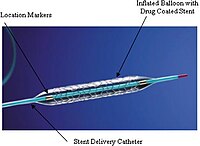
Photo from wikipedia
Background: Genetic alterations in lymphatic development can lead to microcystic lymphatic malformations (micro LMs). LMs can have both microcystic and macrocytic components or be exclusively one or the other. LMs… Click to show full abstract
Background: Genetic alterations in lymphatic development can lead to microcystic lymphatic malformations (micro LMs). LMs can have both microcystic and macrocytic components or be exclusively one or the other. LMs can result in serious, sometimes life-threatening, sequelae. Absent consensus guidelines, treatment has been largely empiric. Recent advances in our understanding of the pathogenesis of micro LMs have provided a foundation for novel therapeutic approaches. This review examines clinical data over the last 10 years on the role of sirolimus, an inhibitor of the PI3K/AKT/mTOR signaling pathway implicated in micro LM development, in the treatment of micro LM. Methods and Results: Systematic review of published clinical studies from January 1, 2011, to July 15, 2021, using the PubMed, Google Scholar, and Cochrane Reviews databases, and utilizing delimiters to focus specifically on sirolimus in the treatment of micro LM. A total of 16 studies were identified (13 case studies or case reviews; 3 prospective) that included 52 subjects treated with topical (n = 15) or oral (n = 37) sirolimus for micro LM. Clinically meaningful, long-term improvement (up to 3 years) was noted in 92% (46/50), mostly previously treated subjects. Sirolimus yielded improvements in key manifestations such as lymphatic leakage, bleeding, vesicle bulk, pain, and skin discoloration. Some subjects experienced a rapid onset of effect (within 2 weeks). No unexpected adverse events were seen. Conclusion: Sirolimus appears to be an effective and safe option in the management of cutaneous and complex micro LM. However, prospective, controlled trials are clearly needed to accurately elucidate the benefits and risks of sirolimus in the management of micro LM. ClinicalTrials.gov Identifier: NCT05050149.
Journal Title: Lymphatic research and biology
Year Published: 2022
Link to full text (if available)
Share on Social Media: Sign Up to like & get
recommendations!